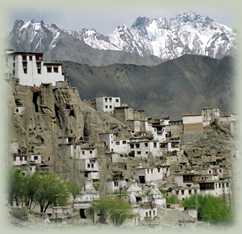Pilgrimage to Ladakh – Northern Himalayas of India
- Active & Adventure

| from $2,798* per person | 13 Days | June |
| Simple accommodations | Exertion level: 6 | |
| Operator: Soul Adventures | 12 people max | |
Situated on the western end of the Himalayas, Ladakh has four major mountain ranges - the great Himalayan, Zanskar, Ladakh and the Karakoram, passing through it. A maze of enormously high snow capped peaks and the largest glaciers outside the polar region dominate the terrain where valley heights range from a mere 8000 ft. to 15,000 ft. while passes of up to 20,000 ft. and peaks reaching above 25,000 ft. can be seen all around. The world's largest glacier outside the polar region, Siechen is here.
The major waterway of Ladakh is the Indus, which enters India from Tibet at Ldemchok. Starting near Mt. Kailash, the Indus according to Mythology, sprouts from the mouth of a loin, and is therefore known as Senge Khababs. Summer temperatures rarely exceed 80F in the shade, while in winter they may plummet to minus 4F even in Leh. Surprisingly though, the thin air makes the heat of the sun even more intense than at lower altitudes. It is said that only in Ladakh a man sitting with his feet in the shade suffers from sunstroke and frostbite at the same time!
The Markha Valley Trek is certainly one of the most varied and beautiful treks in the world. It ventures high into the Himalayas crossing two passes over 15,000 ft (4575m) as it circles from the edges of the Indus Valley, down into parts of Zanskar, and passes through terrain that changes from incredibly narrow valleys to wide-open and vast expanses! It is made all the more interesting by the ancient form of Buddhism that flourishes in the many monasteries that dot the landscape perched high atop the hills. The trails are decorated by elaborate "chortens" (shrines) and "mani" (prayer) walls, which further exemplify the region's total immersion in Buddhist culture. As we trek to the upper end of the Markha Valley we are rewarded with spectacular views of jagged snow capped peaks before crossing the 16,730 ft (5100m) Gongmaru Pass and descending to the famous Hemis Monastery, where we end our trek.
Locations visited/nearby
Leh , Ladakh , Markha Valley , Himalayas
Special information
- May accommodate certain types of disabilities. Contact the operator for more information.
- Family oriented trip.
Itinerary
| Day 1 |
|---|
|
Arrive in Delhi, India |
| Day 2 |
|---|
|
Fly from Delhi to Leh, Explore Leh, Hotel Omasilla |
| Day 3 |
|---|
|
Tour of Ladakh’s Monasteries, Hotel Omasilla Today we’ll visit the monasteries of Shey, Thiksey, and Stakna returning to Leh in the late afternoon. Shey, the former palace of Upper Ladakh, is situated at the top of a hill and commands a breathtaking view of the Indus River. The palace contains a massive statue of the Sakyamuni Buddha – the biggest of its kind in Ladakh. We’ll also visit famous Thiksey monastery, said to be a blessed site and the most well know “Gelugpa”, or yellow sect, Gompa of all. The oldest portion of the building is reputed to date back to the 11th century, and a breathtaking view from the top enables us to see the palaces and monasteries of Leh. Our final stop is Staknasetting on a 60 meter high isolated rock in the center of the Indus valley. It was repainted in 1982 and is now one of the most colorful and bright Gompa’s in Ladakh. After a day of exploration, we will return to the hotel for dinner and reflect on our initial experiences of Leh and the Ladakhi culture. This evening we’ll prepare for our trek that begins tomorrow. |
| Day 4 |
|---|
|
Chilling (10,660ft) to Skiu (10,880ft), Camping
|
| Day 5 |
|---|
|
Skiu (10,880ft) to Markha (12,140ft), Camping
|
| Day 6 |
|---|
|
Rest Day at Markha
|
| Day 7 |
|---|
|
Markha (12,140ft) to Thachungtse (13,620ft), Camping
|
| Day 8 |
|---|
|
Thachungtse (13,620ft) to Nimaling (15,490ft), Camping
|
| Day 9 |
|---|
|
Nimaling (15,490ft) to Chuskurmo (13,350ft), Camping
|
| Day 10 |
|---|
|
Chuskurmo (13,350ft) to Shang Sumdo (12,010ft), Camping
|
| Day 11 |
|---|
|
Shang Sumdo (12,010ft) to Martselang (12,139), Hotel Omasilla Hemis was built in 1630 during the reign of Sengge Namgyal, an illustrious ruler of Ladakh. It flourished under the Namgyal dynasty as the royalty favored the Drugpa sect, which managed the monastery. The Monastery is divided into two, the assembly hall on the right and the main temple on the left. The hall Dukhang also known as the “green room” is used by local dancers during the festival. The temple is known as Tshogkhang. The varandahs have a surfeit of frescoes, among them the Buddhist ‘Wheel of Life’ (Kalachakra) and the lords of the four quarters, besides the prayer wheel. Trek time 3 Hrs; 6 miles
|
| Day 12 |
|---|
|
Explore Leh, Hotel Vasant Continental
|
| Day 13 |
|---|
|
Leh to Delhi, Airport Transfer, Trip Conclusion
|
More information from Soul Adventures:
- View trip on provider's website
www.adventurecentral.com/user/(X(1)S(b52ygxuo2cjdh255cmtefv55… - Company profile, experience, and history
- View all of their trips
- Email this trip page to a friend
-



Comments from Facebook